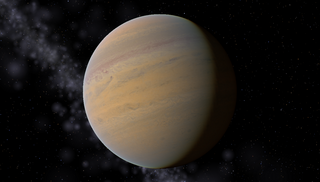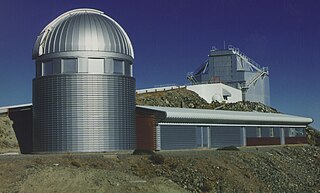Related Research Articles
HD 82943 is a yellow dwarf star approximately 89 light-years away in the constellation of Hydra. Two extrasolar planets have been confirmed to be orbiting it, and it is thought that the system had more giant planets that were "swallowed" by the parent star. HD 82943 is estimated at 1.15 times the mass of the Sun.
HD 169830 is a star in the southern constellation of Sagittarius. It has a yellow-white hue and is dimly visible to the naked eye with an apparent visual magnitude of +5.90. The star is located at a distance of 120 light years from the Sun based on parallax. It is drifting closer with a radial velocity of −17.3 km/s, and is predicted to come as close as 20.7 ly (6.4 pc) in 2.08 million years. HD 169830 is known to be orbited by two large Jupiter-like exoplanets.
HD 75289 is a faint double star in the southern constellation of Vela. The primary component has a yellow hue and an apparent visual magnitude of 6.35. Under exceptionally good circumstances it might be visible to the unaided eye; however, usually binoculars are needed. The pair are located at a distance of 95 light years from the Sun based on parallax, and are drifting further away with a radial velocity of +10 km/s.
HD 130322 is an 8th-magnitude star in the constellation of Virgo. It is an orange dwarf, a type of star somewhat dimmer and cooler than the Sun. Spectral type of the star is K0V. It can only be seen with binoculars or telescope. Being almost exactly on the celestial equator the star is visible everywhere in the world except for the North Pole.

23 Librae b, also known as HD 134987 b, is an extrasolar Jovian planet discovered in November 1999 orbiting the star 23 Librae. It orbits in its star's habitable zone.
HD 11964 c is an extrasolar planet approximately 110 light-years away in the constellation of Cetus. The planet was discovered in a close-orbit around the yellow subgiant star HD 11964. The planet has a minimum mass 35 times the mass of Earth and is located in a mildly eccentric orbit which takes almost 38 days to complete. HD 11964 c was a possible planet discovered on the same day as HD 11964 b in 2005. HD 11964 c was first proposed in a paper published in 2007, and finally confirmed with new data presented in a review of multi-planet systems which appeared on the arXiv preprint website in 2008.
HD 11964 b is an extrasolar planet, a gas giant like Jupiter approximately 110 light-years away in the constellation of Cetus. The planet orbits the yellow subgiant star HD 11964 in a nearly-circular orbit, taking over 5 years to complete a revolution around the star at a distance of 3.34 astronomical units.

79 Ceti b is an extrasolar planet orbiting 79 Ceti every 75 days. Discovered along with HD 46375 b on March 29, 2000, it was the joint first known extrasolar planet to have minimum mass less than the mass of Saturn.
HD 114762 b is a small red dwarf star, in the HD 114762 system, formerly thought to be a massive gaseous extrasolar planet, approximately 126 light-years (38.6 pc) away in the constellation of Coma Berenices. This optically undetected companion to the late F-type main-sequence star HD 114762 was discovered in 1989 by Latham, et al., and confirmed in an October 1991 paper by Cochran, et al. It was thought to be the first discovered exoplanet
HD 222582 b is an extrasolar planet that is 8.37 times the mass of Jupiter orbiting the star HD 222582. The orbital period is 572 days and orbits at a semimajor axis of 1.35 AU in one of the most eccentric orbits of the known planets.
HD 130322 b is an exoplanet with a minimum mass slightly more than that of Jupiter. It orbits the star in a very close orbit distance being only a quarter that of Mercury from the Sun. It is thus a so-called "hot Jupiter". The planet orbits the star every 10 days 17 hours in a very circular orbit.
HD 210277 b is an extrasolar planet orbiting the star HD 210277. It was discovered in September 1998 by the California and Carnegie Planet Search team using the highly successful radial velocity method. The planet is at least 24% more massive than Jupiter. The mean distance of the planet from the star is slightly more than Earth's distance from the Sun. However, the orbit is very eccentric, so at periastron this distance is almost halved, and at apastron it is as distant as Mars is from the Sun.
HD 30177 b is an extrasolar planet located approximately 181.6 light-years away in the constellation of Dorado, orbiting the star HD 30177.
HD 40979 b is an extrasolar planet orbiting the star HD 40979, was detected from the Lick and Keck observatories and photometric observations at Fairborn Observatory reveal low-amplitude brightness variations in HD 40979. It is thought to be a large gas giant planet. It was discovered in 2002 by Debra Fischer.
HD 46375 b is an extrasolar planet located approximately 109 light-years away in the constellation of Monoceros, orbiting the star HD 46375. With 79 Ceti b on March 29, 2000, it was joint first known extrasolar planet less massive than Saturn orbiting a normal star. The planet is a "hot Jupiter", a type of planet that orbits very close to its parent star. In this case the orbital distance is only a tenth that of the planet Mercury. No transit of the planet has been detected, so its inclination must be less than 83°. Because the inclination is unknown, the true mass of the planet is not known.
HD 49674 b, formally named Eburonia, is an extrasolar planet located approximately 134 light-years away in the constellation of Auriga, orbiting the star HD 49674. This planet was discovered orbiting the star in 2002. The planet is a gas giant and orbits extremely close to its star, which takes only 4.95 days to revolve.
HD 208487 b is an extrasolar planet located approximately 144 light-years away in the constellation of Grus, orbiting the star HD 208487. This planet has a minimum mass close to half that of Jupiter and is most probably a gas giant. The planet orbits the star in a close, eccentric orbit. One revolution takes 130 days to complete. This planet was discovered on September 16, 2004 by Tinney, Butler, and Marcy et al. using Doppler spectroscopy to measure the star's radial velocity changing over time as the planet revolves around its orbit.
HD 192263 b, also named Beirut, is a gas giant planet with a mass about three quarters that of Jupiter mass. It orbits the star in a circular orbit completing one revolution in 24 days or so. It was discovered in 2000 by the Geneva Extrasolar Planet Search team. The planet was independently detected by the California and Carnegie Planet Search team.
HD 102117 b, formally named Leklsullun, is a planet that orbits the star HD 102117. The planet is a small gas giant a fifth the size of Jupiter. It orbits very close to its star, but not in a "torch orbit" like the famous 51 Pegasi b. It was one of the smallest extrasolar planets discovered as of 2006.

Leonhard Euler Telescope, or the Swiss EULER Telescope, is a national, fully automatic 1.2-metre (47 in) reflecting telescope, built and operated by the Geneva Observatory. It is located at an altitude of 2,375 m (7,792 ft) at ESO's La Silla Observatory site in the Chilean Norte Chico region, about 460 kilometers north of Santiago de Chile. The telescope, which saw its first light on 12 April 1998, is named after Swiss mathematician Leonhard Paul Euler.
References
- ↑ Butler, R. P.; et al. (2006). "Catalog of Nearby Exoplanets". The Astrophysical Journal. 646 (1): 505–522. arXiv: astro-ph/0607493 . Bibcode:2006ApJ...646..505B. doi:10.1086/504701. S2CID 119067572.
- ↑ Udry, S.; et al. (2000). "The CORALIE survey for southern extra-solar planets II. The short-period planetary companions to HD 75289 and HD 130322". Astronomy and Astrophysics. 356 (2): 590–598. Bibcode:2000A&A...356..590U. Archived from the original on 2012-02-04. Retrieved 2008-06-08.